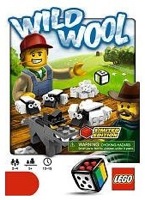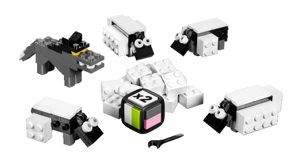by Demian Katz
 Wild Wool
Wild Wool
Published by LEGO (2010)
Designed by Jesper C. Nielsen
Contents: 1 die, 117 LEGO pieces, 1 rulebook, 1 set of building instructions
2-4 players
$9.99
If you grew up playing with LEGO blocks, chances are you still have a
certain affection for them. At least, this is still the case for me.
When I heard a few months ago that LEGO was releasing a series of board
games, some designed by Reiner Knizia, I was intrigued. When I finally
saw a display of these games at the store, I couldn't stop myself from
buying the inexpensive one marked "limited edition." I don't regret the
decision, and I'll probably have more LEGO games in my collection before
too long.
Putting It Together
Of course, part of the joy of LEGO is working through the little
instruction booklets that show you how to put the pieces together. It's
been a couple of decades since I last did this, but I enjoyed the
nostalgia trip. At the end, I had four LEGO sheep and a LEGO wolf.
Thanks to some pieces that I'm pretty sure didn't exist in my youth, the
wolf's tail moves up and down and the sheep's heads are similarly
adjustable. The sheep also have LEGO bumps all the way around their
bodies so that they can grow "wool" in the form of white LEGO cubes.
The game includes a couple of extra small pieces, presumably to replace
any that are lost. These can probably be put to good use elsewhere!
 Also worth mentioning is the LEGO die, which is a feature of most (if
not all) of the new LEGO game series. It's a six-sided die with four
LEGO bumps on each side. By snapping in flat LEGO panels, you can
customize the options presented by the die. In this game, one side gets
a big "x2" while the other sides get two colors each. A little wrench
is provided to help pry the sides off if you want to change the layout
of the die.
Also worth mentioning is the LEGO die, which is a feature of most (if
not all) of the new LEGO game series. It's a six-sided die with four
LEGO bumps on each side. By snapping in flat LEGO panels, you can
customize the options presented by the die. In this game, one side gets
a big "x2" while the other sides get two colors each. A little wrench
is provided to help pry the sides off if you want to change the layout
of the die.
Gameplay
The current crop of LEGO games cover a fairly broad range of ages, and
Wild Wool aims at the young end of the spectrum – ages 5
and up. This, combined with the fact that it is not one of Reiner
Knizia's designs, means that it is not exactly a gamers' game. In fact,
it is rather reminiscent of Cootie in that it consists of rolling
the die and moving plastic pieces around. However, the game deserves
some credit for being a little more thought provoking than much of the
competition. Many games for small children put the players completely
at the mercy of fate. At least Wild Wool gives you a choice on
most turns. At the start of the game, everyone gets a sheep. If you
roll the "x2" side, you get to add two pieces of wool to your sheep. If
you roll any other side, you get to choose one of two possible actions
based on the two colors represented. Options include adding a piece of
wool to your sheep, shearing your sheep (thus keeping all of its wool
for scoring at the end of the game), trading sheep with another player,
or using the wolf to scare off all of a sheep's wool. Any player who
has a fully wool-covered sheep at the beginning of his or her turn gets
a bonus shearing action... but keeping a sheep that woolly can be
challenging! The game ends when the wool supply runs out, at which
point all sheep are sheared one last time, and the person with the most
wool wins.
As you can see, it's a cute but fairly inconsequential game... except
for one other important detail: you can customize it. In keeping with
the LEGO spirit of creativity and experimentation, the rulebook includes
a number of variants: different ways of using the wolf, different die
layouts, how to turn it into a reflex game, etc. These variants are
accompanied by suggestions for devising your own improvements as well as
an online forum for sharing your creations with other players. If you
know a creative child you would like to groom as a game designer (or at
least a BoardGameGeek user), you could do far worse than to give the
gift of LEGO.
Conclusions
Wild Wool was obviously not designed for my demographic –
yet the draw of LEGO is strong, and I have to admit that I actually
enjoyed playing it. I certainly plan on investigating some of the more
complex offerings in the line. I admire the way the game is designed to
encourage customization and creativity. If you're looking for a dose of
nostalgia or a gift for a young gamer-to-be, Wild Wool is a good
choice.


 Wild Wool
Wild Wool Also worth mentioning is the LEGO die, which is a feature of most (if
not all) of the new LEGO game series. It's a six-sided die with four
LEGO bumps on each side. By snapping in flat LEGO panels, you can
customize the options presented by the die. In this game, one side gets
a big "x2" while the other sides get two colors each. A little wrench
is provided to help pry the sides off if you want to change the layout
of the die.
Also worth mentioning is the LEGO die, which is a feature of most (if
not all) of the new LEGO game series. It's a six-sided die with four
LEGO bumps on each side. By snapping in flat LEGO panels, you can
customize the options presented by the die. In this game, one side gets
a big "x2" while the other sides get two colors each. A little wrench
is provided to help pry the sides off if you want to change the layout
of the die.